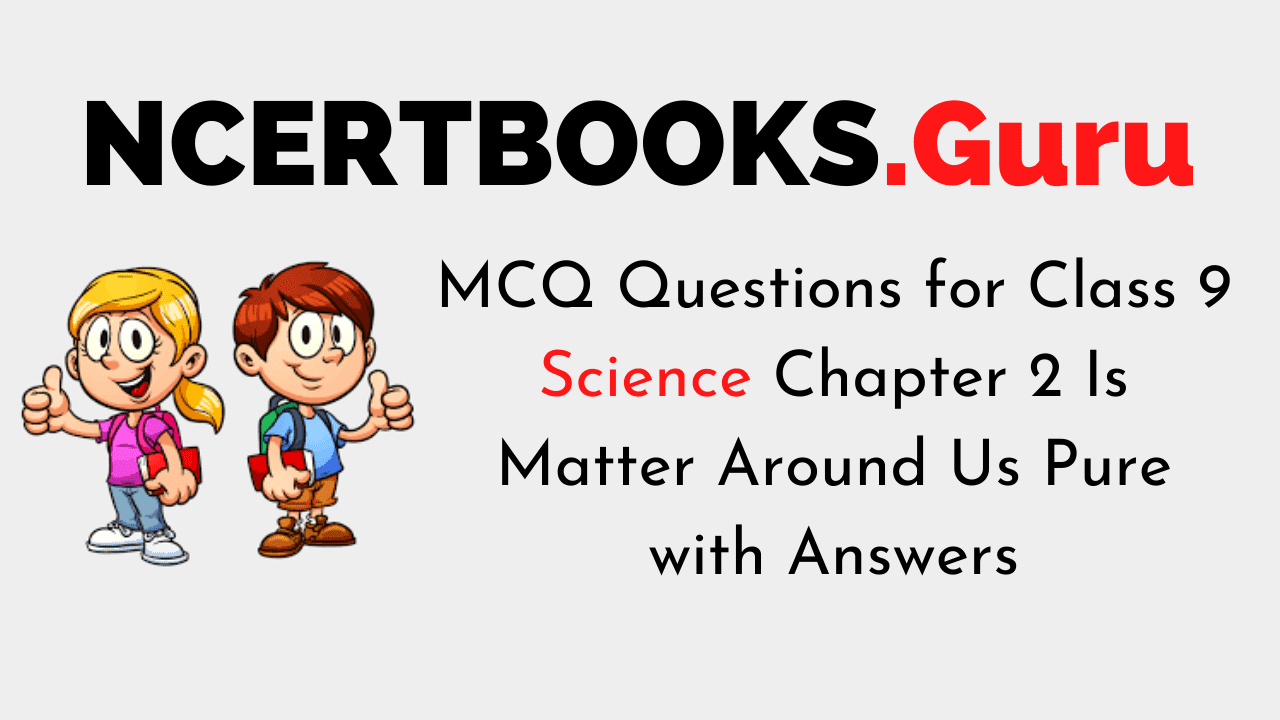MCQ Questions for Class 9 Science Chapter 2 Is Matter Around Us Pure with Answers
MCQs from Class 9 Science Chapter 2 – Is Matter Around Us Pure are provided here to help students prepare for their upcoming Science exam.
MCQs from CBSE Class 9 Science Chapter 2: Is Matter Around Us Pure
1. What is the name of the metal which exists in liquid state at room temperature?
(a) Sodium
(b) Potassium
(c) Mercury
(d) Bromine
Answer/ Explanation
(c) Mercury
2. When the liquid is spun rapidly, the denser particles are forced to the bottom and the lighter particles stay at the top. This principle is used in:
(a) Centrifugation
(b) Fractional distillation
(c) Evaporation
(d) Tunneling
Answer/ Explanation
(a) Centrifugation
3. What is the name of the metal which exists in liquid state at room temperature?
(a) Mercury
(b) Bromine
(c) Sodium
(d) Potassium
Answer/ Explanation
(b) Bromine
Class 9 Science NCERT Book and Solutions PDF
4. Which of the following elements is not a metalloid?
(a) Boron
(b) Silicon
(c) Germanium
(d) Tungsten
Answer/ Explanation
(d) Tungsten
5. If we put camphor in an open container, its amount keeps on decreasing due to the phenomenon of
(a) Evaporation
(b) Precipitation
(c) Condensation
(d) Sublimation
Answer/ Explanation
(d) Sublimation
6. Heterogeneous mixture in which the solute particles do not dissolve and remain suspended throughout the solvent and the solute particles can be seen with the naked eye is known as:
(a) Colloidal solution
(b) Super saturated solution
(c) Sublimation
(d) Suspensions
Answer/ Explanation
(d) Suspensions
7. In tincture of iodine, find the solute and solvent?
(a) alcohol is the solute and iodine is the solvent
(b) iodine is the solute and alcohol is the solvent
(c) any component can be considered as solute or solvent
(d) tincture of iodine is not a solution
Answer/ Explanation
(b) iodine is the solute and alcohol is the solvent
8. The continuous zig-zag movement of colloidal particles in a dispersion medium is called
(a) Dispersion
(b) Tyndall effect
(c) Brownian movement
(d) Oscillation
Answer/ Explanation
(c) Brownian movement
9. A pure substance which is made up of only one kind of atom and cannot be broken into two or more simpler substances by physical or chemical means is referred to as
(a) a compound
(b) an element
(c) a molecule
(d) a mixture
Answer/ Explanation
(b) an element
10. Which of the following non-metal is a good conductor of electricity?
(a) Aluminium
(b) Silicon
(c) Graphite
(d) Gold
Answer/ Explanation
(c) Graphite
11. Which of the following property does not describe a compound?
(a) It is composed of two or more elements
(b) It is a pure substance.
(c) It cannot be separated into constituents by physical means
(d) It is mixed in any proportion by mass
Answer/ Explanation
(d) It is mixed in any proportion by mass
12. When two liquids do not mix, they form two separate layers and are known as
(a) Miscible liquids
(b) Immiscible liquids
(c) Saturated liquids
(d) Super saturated liquids
Answer/ Explanation
(b) Immiscible liquids
Important MCQs from Chapter 1 Matter in Our Surroundings
13. How one can separate ammonium chloride from a mixture containing ammonium chloride and sodium chloride?
(a) Precipitation
(b) Sublimation
(c) Chromatography
(d) Cetrifugation
Answer/ Explanation
(b) Sublimation
14. The amount of solute present per unit volume or per unit mass of the solution/solvent is known as
(a) Composition of solute
(b) Concentration of a solvent
(c) Concentration of a solute
(d) Concentration of a solution
Answer/ Explanation
(d) Concentration of a solution
15. According to the definition of pure substance, which of the following is a pure substance?
(a) Ice
(b) Mercury
(c) Iron
(d) All of these
Answer/ Explanation
(d) All of these
